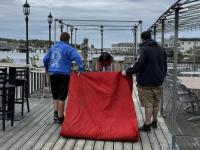Special education report for Boothbay region schools
The annual special education report dated September of this year revealed that of the 591 students enrolled at Boothbay Region Elementary School and Boothbay Region High School (K-12), 125 receive special education services. Special Education Director Jane Stevens added that the 125 also included home-schooled children. Her report did not include information for the rest of the AOS: Southport Central, Edgecomb Eddy and Georgetown Central schools.
Of these students, 46 have been identified as having a learning disability and are primarily in grades 4 through 12.
In a post-meeting conversation, Stevens defined “learning disability.” These students typically have average to above average cognitive skills, but have one area or skill set, for example, reading, verbal or math skills, that is lower than their intelligence suggests it should be.
“I would say the numbers are lower in grades 1 to 3 because we have a good system in place for support and intervention. We (special education educators, ed techs) also have a lot of support from teachers and parents. In the lower grades there is a lot of special instruction given that can bring a student with a learning disability up to their peers,” Stevens said. “Then, decisions have to be made about how to keep their learning level up there.”
Once school is out in June, summer schooling is available to keep students on track.
The report also included the following special education classifications: speech/language, other health, visual or orthopedic impairment, emotional disability, multiple disabilities, intellectual disability and developmental delay.
Stevens said the numbers of autistic children are growing, not just here in Maine, but nationwide. Between BRES and BRHS there are 12 autistic students. She noted that supporting the educational needs of the autistic student requires a great deal of additional training for teachers and special ed techs.
Other rising health issues, Stevens said, are physical limitations and Attention Deficit Disorder (ADD).
Despite all of these challenges, Stevens said the resources at the schools combined with the commitment of teachers and parents, positively impacts the experiences of special education students.
Each special education student has an IEP (individualized education plan). IEPs include the educational goals for the child, what services the child receives and the reasons for the decision. These services can include one-on-one learning with an ed tech or aide, and therapies; what percentage of time a student will spend in the classroom setting with his or her peers, and what the behavioral goals are for the child, progress reports and much more.
For example, if a student has difficulty reading, Stevens said schools have recorded books available and the book itself for the student to try to read along with. At the high school, many of the books used are classics and can be downloaded onto the iPads at no charge. Teachers or ed techs will talk to the child about the book and ask them questions to see how well they comprehend what they have heard.
Some children do not need to continue with special education services, particularly those with a learning disability.
“The kids are already identified before they get to school and when they do, their needs are addressed as soon as they arrive at school from kindergarten and up,” Stevens said.
“There is an ebb and flow to it, but our numbers stay pretty stable. New requests for testing come in, new students come in .... Because they were identified earlier, when some students' have there three-year assessment, they discover they no longer need assistance.”
Budget presentations
The first four school committee meetings of 2014, January 8 and 22 and February 12 and 26, have been allocated for 2014-2015 budget presentations by school administrators.
Next meeting: Wednesday, Dec. 11 at 6 p.m. in the BRHS library.
Event Date
Address
United States





















